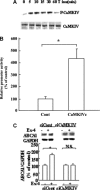Exendin-4 regulates pancreatic ABCA1 transcription via CaMKK/CaMKIV pathway
- PMID: 19874424
- PMCID: PMC3822745
- DOI: 10.1111/j.1582-4934.2009.00955.x
Exendin-4 regulates pancreatic ABCA1 transcription via CaMKK/CaMKIV pathway
Abstract
ATP-binding cassette transporter A1 (ABCA1) in pancreatic beta cells influences insulin secretion and glucose homeostasis. This study investigates whether the long-acting agonist of the glucagon-like peptide 1, namely exendin-4, which mediates stimulatory effects on ABCA1 gene expression, could interfere with the Ca(2+)/calmodulin (CaM)-dependent protein kinase (CaMK) cascade. ABCA1 promoter activity was examined by reporter gene assay in rat insulin-secreting INS-1 cells incubated with exendin-4. CaMKIV activity was assessed by detection of activation-loop phosphorylation (Thr(196)) of CaMKIV. We investigated the influence of the constitutively active form (CaMKIVc) or CaMKIV knockdown on ABCA1 expression. Increased abundance of ABCA1 protein was noted in response to rising concentrations of exendin-4 with maximum induction at 10 nM. Exendin-4 also stimulated ABCA1 promoter activity, but failed to do so in the presence of STO-609, a CaMKK inhibitor. Up-regulation of CaMKIV phosphorylation (at Thr(196)) peaked after 10 min. of exposure to exendin-4. CaMKIVc enhanced or up-regulated ABCA1 promoter activity in INS-1 cells. Furthermore, exendin-4 induction of ABCA1 protein expression was significantly suppressed in cells treated with CaMKIV-siRNA. Activation of the CaMKK/CaMKIV cascade by exendin-4 stimulated ABCA1 gene transcription, indicating that exendin-4 plays an important role in insulin secretion and cholesterol ester content in pancreatic beta cells.
Figures


Similar articles
-
Exendin-4 regulates GLUT2 expression via the CaMKK/CaMKIV pathway in a pancreatic β-cell line.Metabolism. 2011 Apr;60(4):579-85. doi: 10.1016/j.metabol.2010.06.002. Epub 2010 Jul 3. Metabolism. 2011. PMID: 20598720
-
Exendin-4 regulates the expression of the ATP-binding cassette transporter A1 via transcriptional factor PREB in the pancreatic β cell line.J Endocrinol Invest. 2011 Oct;34(9):e268-74. doi: 10.3275/7683. Epub 2011 Apr 26. J Endocrinol Invest. 2011. PMID: 21521937
-
Exendin-4 regulates glucokinase expression by CaMKK/CaMKIV pathway in pancreatic beta-cell line.Diabetes Obes Metab. 2009 Oct;11(10):939-46. doi: 10.1111/j.1463-1326.2009.01067.x. Epub 2009 May 22. Diabetes Obes Metab. 2009. PMID: 19486109
-
Calcium/calmodulin-dependent kinase IV in immune and inflammatory responses: novel routes for an ancient traveller.Trends Immunol. 2008 Dec;29(12):600-7. doi: 10.1016/j.it.2008.08.005. Epub 2008 Oct 17. Trends Immunol. 2008. PMID: 18930438 Review.
-
Regulation and intracellular trafficking of the ABCA1 transporter.J Lipid Res. 2001 Sep;42(9):1339-45. J Lipid Res. 2001. PMID: 11518753 Review.
Cited by
-
Exendin-4 Ameliorates Lipotoxicity-induced Glomerular Endothelial Cell Injury by Improving ABC Transporter A1-mediated Cholesterol Efflux in Diabetic apoE Knockout Mice.J Biol Chem. 2016 Dec 16;291(51):26487-26501. doi: 10.1074/jbc.M116.730564. Epub 2016 Oct 26. J Biol Chem. 2016. PMID: 27784780 Free PMC article.
-
Angiotensin II induces cholesterol accumulation and impairs insulin secretion by regulating ABCA1 in beta cells.J Lipid Res. 2018 Oct;59(10):1906-1915. doi: 10.1194/jlr.M085886. Epub 2018 Aug 14. J Lipid Res. 2018. PMID: 30108153 Free PMC article.
-
Geniposide Ameliorated Dexamethasone-Induced Cholesterol Accumulation in Osteoblasts by Mediating the GLP-1R/ABCA1 Axis.Cells. 2021 Dec 6;10(12):3424. doi: 10.3390/cells10123424. Cells. 2021. PMID: 34943934 Free PMC article.
-
Role of ATP-binding cassette transporter A1 in suppressing lipid accumulation by glucagon-like peptide-1 agonist in hepatocytes.Mol Metab. 2020 Apr;34:16-26. doi: 10.1016/j.molmet.2019.12.015. Epub 2020 Jan 7. Mol Metab. 2020. PMID: 32180556 Free PMC article.
-
The interaction of ApoA-I and ABCA1 triggers signal transduction pathways to mediate efflux of cellular lipids.Mol Med. 2012 Mar 27;18(1):149-58. doi: 10.2119/molmed.2011.00183. Mol Med. 2012. PMID: 22064972 Free PMC article. Review.
References
-
- Drucker DJ, Nauck MA. The incretin system: glucagon-like peptide-1 receptor agonists and dipeptidyl peptidase-4 inhibitors in type 2 diabetes. Lancet. 2006;368:1696–705. - PubMed
-
- Kieffer TJ, Habener JF. The glucagon-like peptides. Endocr Rev. 2000;20:876–913. - PubMed
-
- Brunham LR, Kruit JK, Pape TD, et al. Beta-cell ABCA1 influences insulin secretion, glucose homeostasis and response to thiazolidinedione treatment. Nat Med. 2007;13:340–7. - PubMed
MeSH terms
Substances
LinkOut - more resources
Full Text Sources
Molecular Biology Databases
Miscellaneous

